Being South Asian in the South is an intriguing concept. This is is portrayed somewhat in the movie “Mississippi Masala.” Dynamics between the minorities of South Asians and African Americans is portrayed. There is an underlying tension of determining which group is “higher” and which is “lower.” Egos fly as tensions between the two groups is highlighted in the background while two individuals from both groups fall in love. Even within the South Asian community, there is jostling to determine which group is a “higher” group in some way.
Having had my formative years in North Carolina, I can relate to some of the portrayals. The movie depicts a specific group of South Asians, many of whom happened to own motels and other such businesses. I knew some of these families. Their culture is different from other South Asians from other parts of India, and each sub-caste is aware of the differences.
I have always been amazed, growing up South Asian, how divided people from different parts of India can be. There is the first distinction of either being from the North or from the South. I’m from the North. If you’re from the South, that literally means we have different descendants: the ancestry of Aryans in the North and Dravidians in the South. This is part of what I remember from World History in 10th grade High School and classes in college for my Asian Studies Certificate.
From there, there are many divisions by state, language and caste. I’m a Brahmin, which is supposed to be the highest, priestly class. It’s been diluted as a second generation Indian what that means exactly. Growing up, in rituals it meant all our food was offered first to God. We had a room devoted to being a puja/temple or prayer room. All food was brought there first. I assumed all Brahmins were supposed to be vegetarians, as we were, but I met other second-generation Indians that were not and my former Indian husband and his sister were not, although they were supposedly Brahmins.
Technically, a Brahmin is supposed to be able to perform weddings, which I believe my father had, at least once. Beyond some vague idea of purity, I’ve ceased to understand what it means, if anything, in today’s age. It seems to be a label that doesn’t do much good. I assume that by marrying a caucasion and American, I have violated some Brahmin principle as my husband would not register anywhere in the caste system.
However, for some reason, I believe that for South Asians, marrying someone white would be less shocking than marrying someone black. It is not very logical considering that many South Asians are as dark as many African Americans. Skin color is a hot topic for South Asians, particularly in India. Many companies make a lot of money there for skin lightening creams. I have been amused to see commercials for these products on Indian channels on my Direct TV. Somehow, being “fair” increases one’s worth in India. You would NEVER see an Indian in a tanning booth! It is hard for Indians to understand how much one in the states can spend to tan!
Perhaps it is this preoccupation that the movie was touching on as well. Why must society create a hierarchy? It seems that if we were to look closely in most communities, this would exist. Perhaps this is related to the concept of “keeping up with the Joneses.” I bet that if you put any group of people in a room, before long, you would find an order of who is the leader and who is at the bottom rung. Reality shows seem to thrive on this. This characteristic of ours just doesn’t seem very civilized or spiritually advanced.

